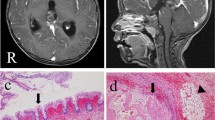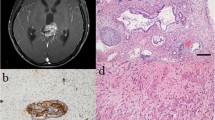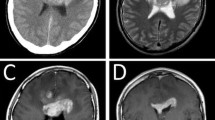Abstract
We present the rare case of a 31-year-old man who developed a germinoma 22 years after resection of a mature teratoma of the pineal region. The initial stereotactic biopsy showed a granulomatous inflammation, but no malignant cells. The correct diagnosis could only be confirmed in a second cerebral biopsy, allowing for proper treatment with radiation therapy. The need to consider metachronous germinoma in this setting is discussed.


Similar content being viewed by others
References
Ueno T, Tanaka YO, Nagata M et al (2004) Spectrum of germ cell tumors: from head to toe. Radiographics 24:387–404
Sugimoto K, Nakahara I, Nishikawa M (2002) Bilateral metachronous germinoma of the basal ganglia occurring long after total removal of a mature pineal teratoma: case report. Neurosurgery 50:613–616; discussion 616–617
Tohma Y, Kaneko T, Kita D et al (2000) De novo spinal teratoma after treatment of an intracranial germ cell tumor. Pediatr Neurosurg 33:261–264
Kim JM, Cheong JH, Yi HJ et al (2002) Metachronous germinoma after total removal of mature teratoma in the third ventricle: a case report. J Korean Med Sci 17:287–291
Iwamuro Y, Seo S, Hirose Y et al (2002) Intrathecal and intraperitoneal germinomas occurring 20 years after total removal of a pineal teratoma. Case report. J Neurosurg 96:364–367
Reis F, Faria AV, Zanardi VA et al (2006) Neuroimaging in pineal tumors. J Neuroimaging 16:52–58
Prosch H, Grois N, Bokkerink J et al (2006) Central diabetes insipidus: is it Langerhans cell histiocytosis of the pituitary stalk? A diagnostic pitfall. Pediatr Blood Cancer 46:363–366
Kraichoke S, Cosgrove M, Chandrasoma PT (1988) Granulomatous inflammation in pineal germinoma. A cause of diagnostic failure at stereotaxic brain biopsy. Am J Surg Pathol 12:655–660
Author information
Authors and Affiliations
Corresponding author
Electronic supplementary material
Below is the link to the electronic supplementary material.
11060_2008_9554_MOESM1_ESM.pdf
Suppl. Fig. 1: Coronar sections of a T1-weighted Magnetic Resonance Imaging: (a) No pathological contrast enhancement can be seen in January 2006 (white arrowhead). (b) Pathological contrast enhancement of the ependymal layer along the ventricles in April 2006 (white arrowhead). (PDF 39 kb)
11060_2008_9554_MOESM2_ESM.pdf
Suppl. Fig. 2: Sagittal sections of a T1-weighted Magnetic Resonance Imaging: No pathological contrast enhancement is noted in the follow-up MRI (white arrowhead). (PDF 394 kb)
Rights and permissions
About this article
Cite this article
Janzarik, W.G., Müller, K., Lübbert, M. et al. Occurrence of a germinoma 22 years after resection of a mature cerebral teratoma. J Neurooncol 88, 217–219 (2008). https://doi.org/10.1007/s11060-008-9554-0
Received:
Accepted:
Published:
Issue Date:
DOI: https://doi.org/10.1007/s11060-008-9554-0




